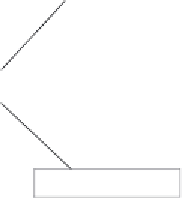Java Reference
In-Depth Information
Here, we get the new
id
for the record to be inserted, set it on the bean that was
passed in, and then insert that bean into the database. The code is very simple to
follow, just a bit verbose when compared to either the i
BATIS
or Hibernate versions.
The other methods are equally straightforward, so we will not take up any
more space on them.
11.2 Using the DAO pattern with other data sources
The
DAO
pattern is very similar to the Gateway pattern, which makes it suitable
for many other data sources such as
LDAP
or web services.
If you are not familiar with the Gateway pattern, it is also sometimes referred to
as a Wrapper, because that is what it does. It “wraps” an
API
to make it look like a
simple object, as shown in figure 11.1, where the
WebServiceGateway
interface
hides the underlying implementation.
If you are thinking that sounds familiar, it should, because that is also the idea
behind the
DAO
pattern, which is just a specialized gateway that also helps you
manage transactions, pooling, and other database-specific issues.
11.2.1
Example: using a DAO with LDAP
LDAP
is an awesome tool for storing hierarchical data, and is often used by net-
work administrators for tracking users, group memberships, and other similar
data. For example, both Novell Directory Services (
NDS
) and Microsoft's ActiveDi-
rectory are based on
LDAP
and expose
LDAP
API
s.
Using the
DAO
pattern to access a directory using
LDAP
is a great way to keep
the nuances of
JNDI
programming out of your application code. By creating a
Actual Web
Service
ServiceClient
«interface»
WebServiceGateway
MockWebService
Figure 11.1
The DAO pattern is similar to the Gateway pattern.






















